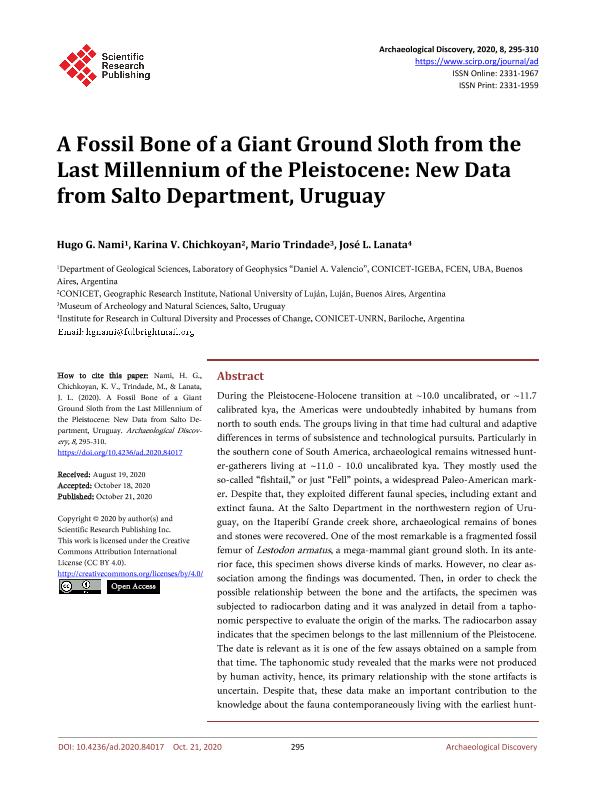Mostrar el registro sencillo del ítem
dc.contributor.author
Nami, Hugo Gabriel

dc.contributor.author
Chichkoyan, Karina Vanesa

dc.contributor.author
Trindade, Mario
dc.contributor.author
Lanata, Jose Luis

dc.date.available
2021-10-27T12:04:51Z
dc.date.issued
2020-10
dc.identifier.citation
Nami, Hugo Gabriel; Chichkoyan, Karina Vanesa; Trindade, Mario; Lanata, Jose Luis; A fossil bone of a giant ground sloth from the last millennium of the pleistocene: New data from Salto department, Uruguay; Scientific Research Publisher; Archaeological Discovery; 8; 4; 10-2020; 295-310
dc.identifier.issn
2331-1959
dc.identifier.uri
http://hdl.handle.net/11336/145192
dc.description.abstract
During the Pleistocene-Holocene transition at ~10.0 uncalibrated, or ~11.7 calibrated kya, the Americas were undoubtedly inhabited by humans from north to south ends. The groups living in that time had cultural and adaptive differences in terms of subsistence and technological pursuits. Particularly in the southern cone of South America, archaeological remains witnessed hunter-gatherers living at ~11.0 - 10.0 uncalibrated kya. They mostly used the so-called “fishtail,” or just “Fell” points, a widespread Paleo-American marker. Despite that, they exploited different faunal species, including extant and extinct fauna. At the Salto Department in the northwestern region of Uruguay, on the Itaperibí Grande creek shore, archaeological remains of bones and stones were recovered. One of the most remarkable is a fragmented fossil femur of Lestodon armatus, a mega-mammal giant ground sloth. In its anterior face, this specimen shows diverse kinds of marks. However, no clear association among the findings was documented. Then, in order to check the possible relationship between the bone and the artifacts, the specimen was subjected to radiocarbon dating and it was analyzed in detail from a taphonomic perspective to evaluate the origin of the marks. The radiocarbon assay indicates that the specimen belongs to the last millennium of the Pleistocene. The date is relevant as it is one of the few assays obtained on a sample from that time. The taphonomic study revealed that the marks were not produced by human activity, hence, its primary relationship with the stone artifacts is uncertain. Despite that, these data make an important contribution to the knowledge about the fauna contemporaneously living with the earliest hunt er-gatherer that were foraging the regional landscape during one of the colonization events that populated the southern cone of South America.
dc.format
application/pdf
dc.language.iso
eng
dc.publisher
Scientific Research Publisher
dc.rights
info:eu-repo/semantics/openAccess
dc.rights.uri
https://creativecommons.org/licenses/by-nc/2.5/ar/
dc.subject
FOSSIL BONES
dc.subject
LESTODON ARMATUS
dc.subject
TAPHONOMY
dc.subject
LATE PLEISTOCENE
dc.subject
RADIOCARBON DATE
dc.subject
SOUTH AMÉRICA
dc.subject.classification
Arqueología

dc.subject.classification
Historia y Arqueología

dc.subject.classification
HUMANIDADES

dc.title
A fossil bone of a giant ground sloth from the last millennium of the pleistocene: New data from Salto department, Uruguay
dc.type
info:eu-repo/semantics/article
dc.type
info:ar-repo/semantics/artículo
dc.type
info:eu-repo/semantics/publishedVersion
dc.date.updated
2021-01-27T19:52:28Z
dc.identifier.eissn
2331-1967
dc.journal.volume
8
dc.journal.number
4
dc.journal.pagination
295-310
dc.journal.pais
Estados Unidos

dc.journal.ciudad
Irvine
dc.description.fil
Fil: Nami, Hugo Gabriel. Universidad de Buenos Aires. Facultad de Ciencias Exactas y Naturales. Departamento de Geología. Instituto de Geofísica "Daniel Valencio"; Argentina. Consejo Nacional de Investigaciones Científicas y Técnicas. Oficina de Coordinación Administrativa Ciudad Universitaria. Instituto de Geociencias Básicas, Aplicadas y Ambientales de Buenos Aires. Universidad de Buenos Aires. Facultad de Ciencias Exactas y Naturales. Instituto de Geociencias Básicas, Aplicadas y Ambientales de Buenos Aires; Argentina
dc.description.fil
Fil: Chichkoyan, Karina Vanesa. Consejo Nacional de Investigaciones Científicas y Técnicas; Argentina. Universidad Nacional de Lujan. Rectorado. Instituto de Investigaciones Geograficas; Argentina
dc.description.fil
Fil: Trindade, Mario. Museo de Arqueología y Ciencias Naturales; Uruguay
dc.description.fil
Fil: Lanata, Jose Luis. Consejo Nacional de Investigaciones Científicas y Técnicas. Centro Científico Tecnológico Conicet - Patagonia Norte. Instituto de Investigaciones en Diversidad Cultural y Procesos de Cambio. Universidad Nacional de Río Negro. Instituto de Investigaciones en Diversidad Cultural y Procesos de Cambio; Argentina
dc.journal.title
Archaeological Discovery
dc.relation.alternativeid
info:eu-repo/semantics/altIdentifier/url/https://www.scirp.org/journal/doi.aspx?doi=10.4236/ad.2020.84017
dc.relation.alternativeid
info:eu-repo/semantics/altIdentifier/doi/http://dx.doi.org/10.4236/ad.2020.84017
Archivos asociados
